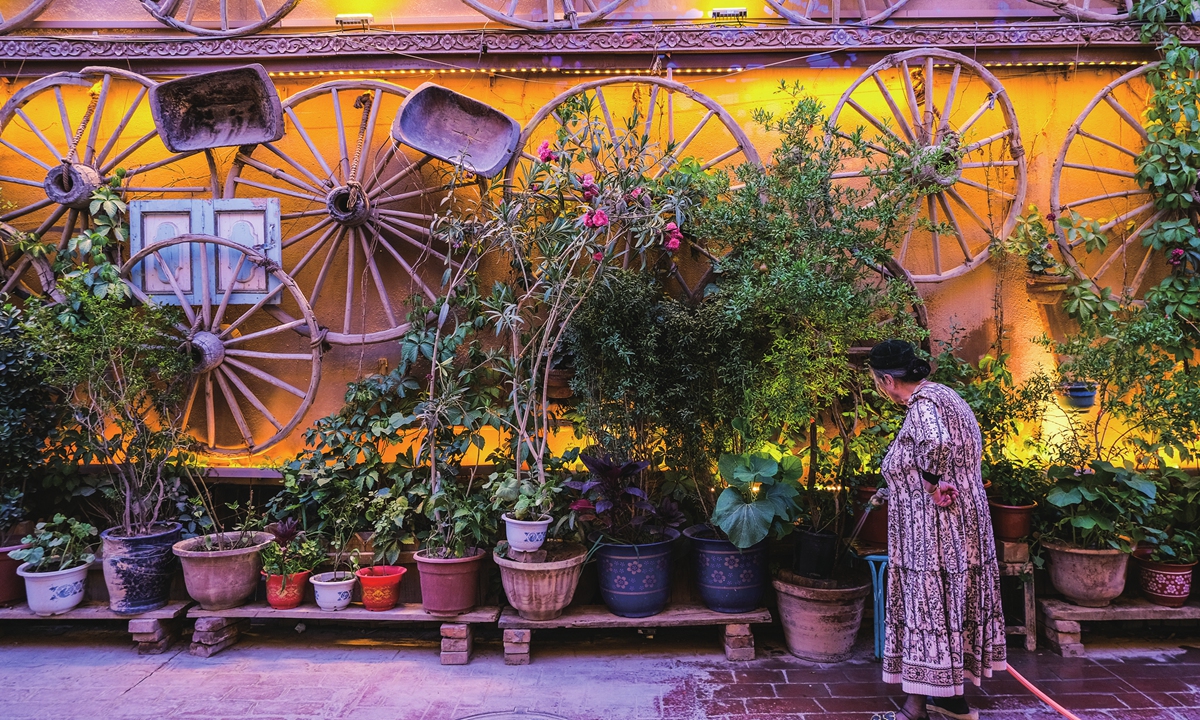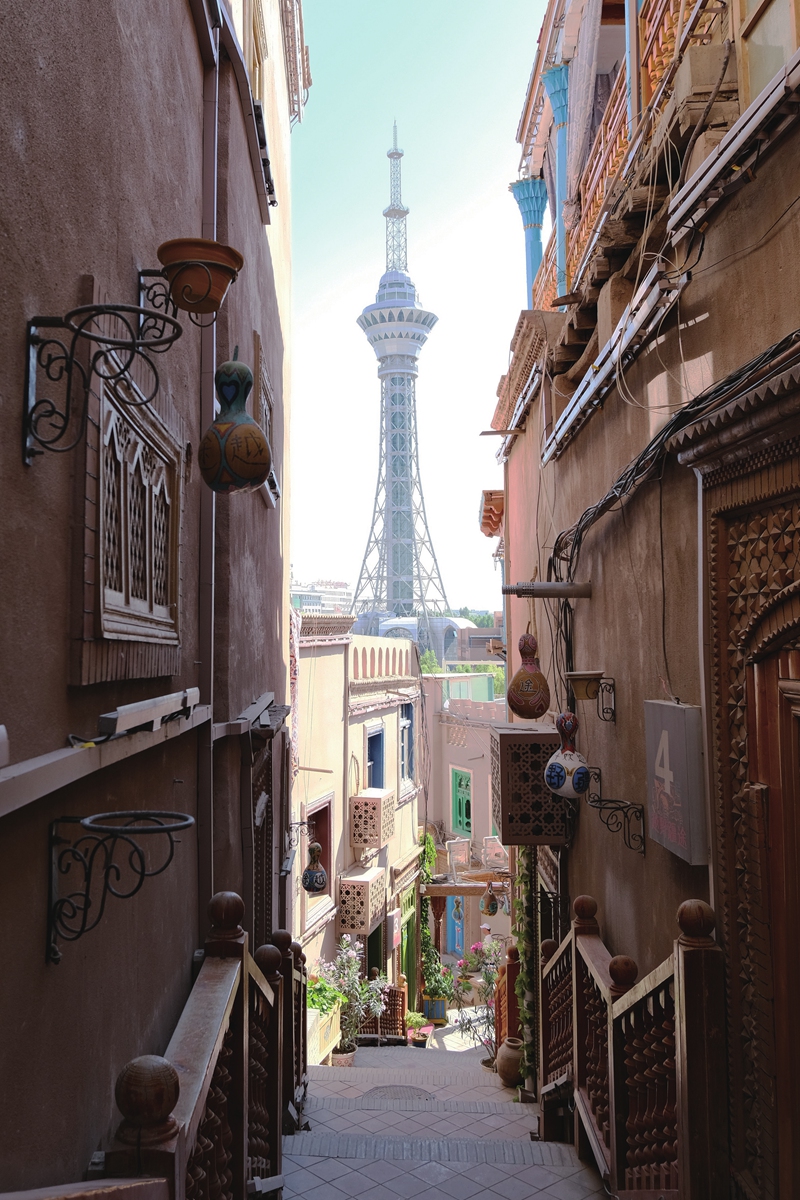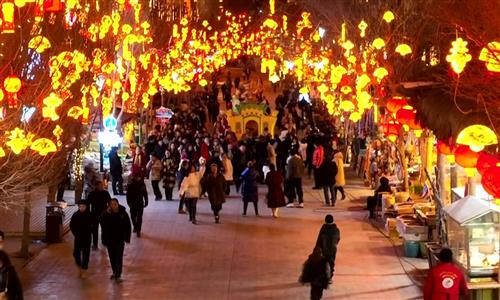ARTS / CULTURE & LEISURE
Explore Kashi’s rich cultural heritage
Hidden Jewel

A local woman waters flowers in Kashi Photo: Bi Mengying/GT
The sun sets at around 10:30 pm in Kashi, Northwest China's Xinjiang Uygur Autonomous Region in June. Against the vast blue sky and distant mountains, the mosques and ancient buildings shimmer in the orange and golden dusk. While the crowd take out their mobile phones and cameras to capture the "latest sunset" in China, the vibrant nightlife of the city is just starting.
Situated in southern Xinjiang, Kashi is a city with a 1,000-year history that boasts a rich ethnic flavor and deep cultural heritage. Historically a vital commercial center along the ancient Silk Road, Kashi remains a key crossroads for Eastern and Western economic and cultural exchanges. It continues drawing visitors from across China and around the world.
On the second-floor balcony of a century-old teahouse, visitors leisurely sip their tea while taking in the scenery of the old city. The night breeze carries the beautiful sound of rawap, a traditional Uygur instrument, to every corner of the maze-like streets in the old city.
Back in the prosperous days of the ancient Silk Road, the teahouses served as rest stops for merchants traveling along the road. Conversations and stories were shared over tea, transforming the teahouses into an information hub. With tea gradually becoming a part of the local people' daily lives since then, the old teahouses in Kashi continued to thrive, preserving the cherished memories of Silk Road tea traders.
Visitors can take a ride on the sightseeing cars or simply walk down the maze-like streets of the old city. Various bazaars dedicated to jade, copper and hats, also offer a unique and fascinating sight. A variety of shops and stalls are worth visiting, selling traditional Uygur pottery, food, handicrafts and musical instruments, some of which have been enlisted as intangible cultural heritage.
Original charm
Exploring the local residences adorned with colorful wooden doors, windows and brick carvings is also a great option for visitors who want to better understand the locals' way of living. One local residence, in particular, has been consistently drawing in tourists. Upon entering the courtyard, visitors are greeted by a large tapestry depicting the "Twelve Muqam" hanging on the wall. The Twelve Muqam, regarded as the mother of Uygur music, is a musical form that combines sung poetry, storytelling and music. This tradition, like many others in Xinjiang, is being preserved and passed down to future generations.
Salmatgul Kari, 33, turned her home into a guesthouse. The first floor hosts exhibitions of folk culture, while the second floor has been converted into guest rooms with different styles. In the middle of the courtyard, is a carpet-covered stage that hosts exuberant traditional music and dance performances of different ethnic minority groups in Xinjiang.
In 2010, the renovation project of the core area of the old city officially began, with major progress in the outer areas being made in 2013. This significantly improved the living conditions of local residents and transformed the old city into a booming tourist attraction.
Kari studied tourism and worked as a tour guide in Kashi. With the renovation project in smooth progress, she decided to transform her home to this guesthouse in 2017, welcoming guests from all over the country.
"While tourists are drawn to the performances, they also develop a great interest in other aspects of Uygur culture and traditions. And we are also giving performances of other ethnic minority groups from Xinjiang, so this becomes a window to showcase their cultures too," Kari told the Global Times.
Despite the modernization, the old city retains its original charm. "The local culture has been well-preserved, as you can see in the architecture, the handicrafts and local people's way of living." The renovation of the old city has brought many tourists and played a key role in preserving and passing on local ethnic culture, enhancing communication and understanding between ethnic groups, she added.
Modern landmarks
After enjoying the exploration of the Ancient City of Kashi, visitors may enjoy visiting the nearby Kunlun Tower. The 169-meter-tall building opened to the public in April 2023, becoming an up-and-coming landmark of the city. Open till 2 am, the tower offers a panoramic night view of the city.
After a good night sleep, it would be wise to visit some air-conditioned museums to stay away from the daytime heat. While the Kashi Museum introduces the region's history and culture, there are also specialized ones such as the Comprehensive Management Memorial Hall for the Protection of the Old Town of Kashi City.
Moreover, the iconic Id Kah Mosque surely deserves a visit as well. Built more than 500 years ago, the well-preserved landmark remains a crucial center for local Muslims to engage in religious activities. Featuring a yellow façade and two 18-meter-tall minarets, the Id Kah Mosque was listed as a key national cultural relic unit in 2001. In recent years, the Chinese government has allocated substantial funds for the preservation of the cultural relic site as well as the upgrading of the infrastructure within the mosque, providing a convenient environment for the religious community.
With its dynamic culture, historical significance and dedicated preservation efforts, Kashi is a must-visit destination for anyone interested in the Silk Road's legacy and beyond. Come visit and explore the unique and unforgettable city of Kashi.

An alley in the Ancient City of Kashi Photo: Bi Mengying/GT


